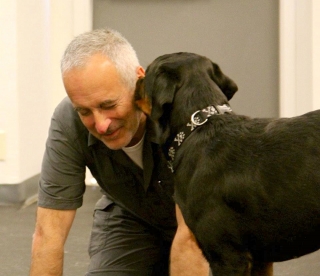Pacifying Behavior in Dogs

Pacifying behavior (Latin pacificare, from pax = peace and facere, facio = to make) is all behavior with the function of decreasing or suppressing an opponent’s aggressive or dominant behavior. There are two ways of classifying pacifying behavior: (1) to include all behaviors with the function of diffusing social conflict, and (2) to restrict it to a particular range within the broader spectrum of conflict decreasing behavior (see diagram). This author prefers the latter because the broad use of the term in the first option makes it synonymous with conflict decreasing behavior in general, without reference to any particular sub-class of this behavior.
Pacifying behavior is closely related to friendly behavior (including greeting behavior), insecure, submissive and fearful behavior. In general, the differences between these behavior displays are quantitatively small, but we can classify them separately and qualitatively according to their respective sub-functions. An animal pacifies another by means of a complex sequence of different behaviors as we can see in the diagram below. An animal very seldom shows a single behavior. Also, the same behavior may achieve different functions depending on its intensity and the sum of all behaviors displayed at a given moment.
Pacifying behavior did not originate as a deliberate and well-thought strategy to manipulate an opponent. Initially, it was probably just a reflex. Like all phenotypes, it happened by chance and evolved thereafter.
Natural selection favors behaviors that prolong the life of an animal and increase its chance of reproducing; over time pacifying behavior spread throughout the population. Evolution favors a systematic bias, which moves behavior away from maximization of utility and towards maximization of fitness.
The origin of pacifying behavior—Animal A facing aggressive opponent B registers (sensory system) B’s behavior, processes it (neurological system) and responds with a behavior. This behavior (probably an infantile behavior) is then registered by aggressive animal B; some behaviors tend to pacify it (probably eliciting parental behavior) while others do not. The pacified state of B benefits A and reinforces its behavior, i.e. it is likely it will repeat the same behavior in similar circumstances. Most importantly, animals that show appropriate pacifying behavior (such as A) survive conflicts and avoid injury more often than not and subsequently pass their genes onto the next generation.
Pacifying behavior also pacifies the pacifier, which is an important feature of this behavior. By displaying pacifying behavior, an insecure animal attempts to regain some security (homeostasis) by displaying a behavior it knows well and has previously served to reassure it.
Some pacifying behavior has its origins in neonatal and infantile behavior and only becomes pacifying behavior through redirection and eventually ritualization. Other forms of pacifying behavior rely on concealing all signs of aggressive behavior. Sexual behavior can also function as pacifying. Young animals of social species learn pacifying behavior at a very early age; it is important that young animals are able to pacify adults when they begin interacting with them. The disposition (genotype) to display the behavior is innate (otherwise the phenotype would not be subject to natural selection and evolution), although it requires reinforcement for the young animal to be able to apply it successfully. In canines, adults (initially the mother at the time of weaning) teach the cubs/pups the intricacies of pacifying behavior, a skill they will need to master in order to prevent or resolve hostilities that could cause serious injuries.
Even though pacifying behavior is more relevant and developed in social species, we also find pacifying displays in the behavior repertoire of less social species. Animals use successfully the pacifying behavior characteristic of their own species with individuals belonging to other species (if possible) because of the common elements of pacifying behavior across species. It is not unusual to see our domestic animals, dogs, cats and horses interacting peacefully and exchanging pacifying signals. Dogs also show friendly, insecure, pacifying or submissive behavior to their owners and other humans with species characteristic displays; licking, nose poking, muzzle nudging, pawing and twisting are common behaviors that dogs offer us.
Enjoy a peaceful day,
R—
For the full article including photos and part of the canine ethogram for social and agonistic behavior, please click here.




